|
|
|
Published
on 2
Jul 2009
|
All rights reserved.
|
|
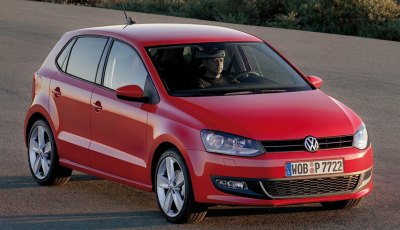
|
Volkswagen deliberately shaped it like
Golf in order to be benefited from the latter's strong image...
|
Since 1975,
Volkswagen has
sold
10.6 million copies of Polo in 4 generations. Traditionally this is
Wolfsburg’s smallest car, sitting under Golf and targeting at singles
or young couples who are buying their first cars. The 5th generation
Polo launched this March takes more or less the same role. It competes
with Ford Fiesta, Peugeot 207, Renault Clio, Opel Corsa and FIAT Grande
Punto etc. in the crowded European supermini segment. How can it
distinguish itself from others? The answer is by means of “Golfness”.
The new Polo looks really like a baby Golf, thanks to a familiar boxy
shape and a nose resembling its bigger brother. Volkswagen deliberately
shaped it like Golf in order to be benefited from the latter's strong
image. In particular, it wants people to see Polo as a classless,
high-quality vehicle like its brother. It may be a conservative design,
but it has a lot of subtle details to appreciate and high-quality fit
and finish to match, so it is a sharp contrast to the expressive
designs of its competitors.
Like Golf VI as well, the cabin of Polo is not very interesting to look
at, but its build quality is doubtless. The dashboard (except on the
entry-level model) is made of soft-touch plastics and solidly screwed
in place. Switch gears have the tactility and robustness you would
expect in a Volkswagen product. The only implication of its cost
savings are the hard door panels, yet that is understandable for its
price. Also in Volkswagen’s fashion, the controls are ergonomically
sited and intuitive to use, the driving position is easily adjustable
and the seats are supportive. What it lost in style is fully
compensated in function.
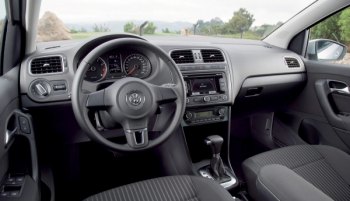
|
What it lost in style here is fully
compensated in function and quality...
|
However,
the cabin is not apparently larger than before – Volkswagen said rear
passengers get only 8 mm extra knee room, while front passengers get 22
mm more shoulder room. That said, it is still capable of packing four
six-footers for city trips.
Outside, the new Polo is not much bigger than the old car – just 54 mm
longer, 32 mm wider and 13 mm lower. Volkswagen carefully controlled
its size and weight. By using more high-strength steel, improving the
structural design of chassis members and using additional welding and
gluing, it managed to reduce body weight by 7.5 percent. Even equipped
with standard ESP and 6 air bags as part of the effort to achieve
5-star Euro NCAP rating, the whole car still managed to be lighter than
the last generation. For instance, the 5-door Polo with 1.2-liter 12V
engine has its kerb weight reduced from 1055 to 992 kg. This mean it
can adopt smaller and more fuel efficient engines.
At launch, the Polo offers 4 petrol and 3 diesel engines. The first 3
petrol engines are carried over from the last generation - 1.2-liter
3-cylinder 6-valve (60hp) and 12-valve (70hp) and 1.4-liter 4-cylinder
16V (85hp). We used to recommend the high power version of the 3-pot
engine as it was reasonably smooth and free-revving - its first order
vibration is fully canceled by a balancer shaft. Now with less weight
to haul it continues to get our recommendation.
However, the star of the range should be the new 1.2 TSI, powered by an
advanced 4-cylinder engine with direct injection and a small
turbocharger. Volkswagen said it is to replace conventional 1.6-liter
engine, which sounds reasonable for its 105hp output, but its peak
torque of 129 lb-ft, available from 1500-3500 rpm, is easily a match
with a 1.8-liter. This mean it rarely needs to rev beyond mid-range.
You get superb refinement and 51 mpg fuel economy from it.
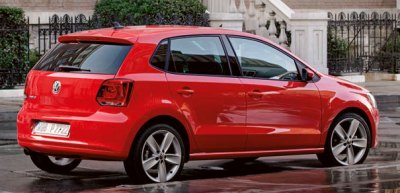
|
It is a competent car by any objective
measurements, just not very entertaining to drive...
|
The 3 diesel engines are all 1.6-liter with common-rail
injection (goodbye to Pump injection), just in different states of tune
- 75hp, 90hp or 105hp. All return 72 mpg and 102 g/km of CO2
emission. Next year will arrive a super frugal BlueMotion with 1.2 TDI
three-pot diesel turbo engine, automatic start-stop, low drag
treatment, low rolling resistance tire and regenerative braking to
achieve 85 mpg and only 87 g/km. We'll look at that then.
Apart from good engines, the new Polo has good transmissions too.
Standard to the 1.2TSI is a slick-shifting 6-speed manual. Optional is
a 7-speed DSG twin-clutch gearbox.
The only area it fails to match some rivals is handling. The new Polo
might be benefited by 30mm wider tracks, revised front suspensions
geometry and a stiffer chassis, but its driving characteristic is still
biased towards high-speed stability than cornering agility. Its turn-in
is not as sharp as the best of the class, in particular Ford Fiesta. It
has more safe understeer built into the chassis. In typical Volkswagen
way, it offers plenty of grip and tight body control, a slightly firm
yet supple ride unless on optional 17-inch wheels. It is a competent
car by any objective measurements, just not very entertaining to drive.
Keen drivers could be better served in Fiesta, Mazda 2 or 207. However,
if you do a lot of motorway job everyday, the Polo may satisfy you with
its superior stability and superb high-speed refinement. After all,
this is a German car. |
Verdict:     |
Published
on 22
May 2010
|
All rights reserved.
|
|
Polo GTI
|
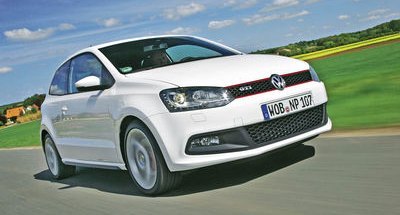
|
A mini Golf GTI with equal performance
|
In
many ways Polo GTI
reminisces the early Golf GTI - it is light and compact; It packs more
than enough firepower to enable a startling performance; Its interior
is solid and honest - even the tartan cloth seats resemble the original
GTI. Those complaining the Golf GTI has grown too big over the years
will be delighted with its little brother. Sharing much of the exterior
design with Golf - no matter body profile, nose, headlights or wheels -
the Polo GTI could be said as a mini Golf GTI.
Moreover, it loses virtually no performance to its big brother. Thanks
to the 1.4TSI twin-charger engine (also found under the bonnet of SEAT
Ibiza Cupra and Skoda Fabia vRS), with 180 horsepower and abundance of
torque across a very wide band, also the standard 7-speed DSG gearbox
and a kerb weight undercutting its big brother by over 200 kilos, the
Polo GTI is able to crack 0-60 mph in 6.6 seconds, i.e. identical to a
manual Golf GTI !!
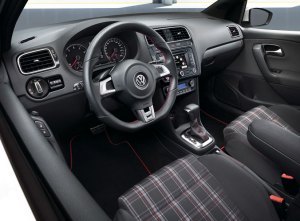
|
The solidity, honesty and tartan cloth
seats reminisce the early Golf GTI
|
The chassis also gets modifications similar to its big brother. To tame
understeer and wheelspin in corners, it is equipped with the
brake-actuated XDS electronic differential like Golf. Suspensions are
stiffened and lowered by 15 mm. The same 17-inch alloy wheels of Golf
GTI are wrapped with low-profile Dunlop SP Sport Maxx rubbers. The only
thing it doesn't get is electronic adaptive damping, which is too
costly for the small car.
On the road, the Polo GTI is easy to drive fast. Its power delivery is
so linear and the paddle-shift DSG gearbox is so easy to use. Its
chassis offers good grip and body control. The suspension feels firmer
than that of Golf GTI, but still leaves enough compliance for B-roads.
It also cruises on motorway with good refinement, thanks to a long 7th
gear and good noise insulation.
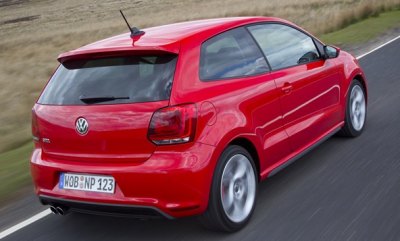
|
Startling performance fails to engage
drivers
|
Nevertheless, the Polo is hard to
engage its driver. The flip side of a refined powertrain is lack of
drama. With a flat torque curve, there is hardly any encouragement to
rev the engine to its 7000 rpm redline. With a paddle-shift gearbox
that upshifts automatically for you, you are devoid of the fun for
challenging yourself and feeling the mechanical engagement through the
gate. The same can be said to its handling. XDS is effective as a
safety net, but it is no replacement to an inherently well balanced
chassis. Carry power into a bend, the ESP light flashes fiercely to
remind you it is now under the control of computer and say goodbye to
mid-corner adjustability. Meanwhile, the helm tugs a little in your
hands, speaking of torque steer instead of real communication from the
front wheels. The overall driving experience is hardly inspiring.
So don't be deceived by your eyes. The new Polo GTI is not a spiritual
successor to the original Golf GTI. While it is a fast and highly
efficient grand covering machine, it is not exactly a driver's car,
unlike FIAT Punto Abarth SS, Renault Clio RS or Mini Cooper S. |
Verdict:     |
| Published
on 25
Apr
2014 |
All rights reserved.
|
|
Polo facelift 2014
|
|
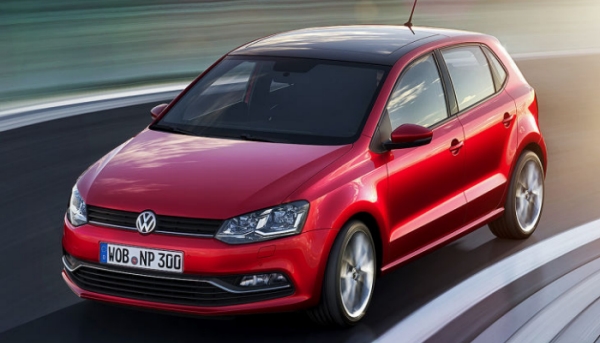
|
Good cars sustain the test
of time better. That is why Volkswagen Polo doesn’t get a facelift
until it is 5 years old. To call it a “facelift” is somewhat
misleading, because you will be hard pressed to tell the subtly revised
headlamps and front bumper. Likewise, changes to the interior are
subtle. There is a new steering wheel, revised instruments, some
different buttons and a new multimedia touch screen. That’s all.
However, as the Polo has always been known for solid, high-quality and
refined, there is really no need for big changes.
In fact, most work can be found under the bonnet. In a bid to meet Euro
6 emission requirements and reduce fuel consumption, most of the old
engines have been replaced. The old 1.2-liter three-cylinder with 70 hp
is replaced with a new, lightweight 1.0-liter VVT triple coming from
Up, producing either 60 hp or 75 hp. It is smoother and more frugal
than the old unit, if no faster. The 1.2 TSI four-pot has been upgraded
to 16 valves, gaining 5 horsepower for a total of 110 hp (there is also
a 90 hp version). The old 1.6 TDI is a bit large and thirsty for a
small car, so it is substituted with a new 3-cylinder 1.4 TDI with the
same outputs – either 75hp, 90 hp or 105 hp – the least powerful one
manages an astonishing 91 mpg and 82g/km of CO2
emission! And to our surprise, the combination of long-stroke diesel
and 3 cylinders does not result in more vibration and noise than the
4-cylinder. Well done.
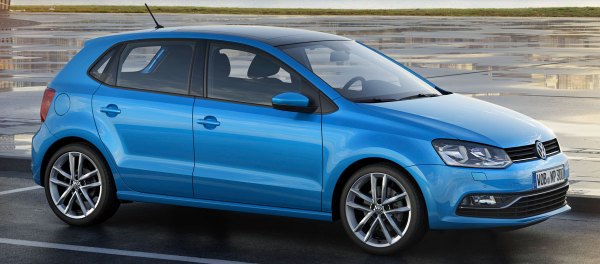
|
Later this year there will be some more interesting engines to join the
range, including a 95 hp turbocharged version of the 1.0 triple, a 150
hp 1.4 TSI with ACT cylinder deactivation and, finally, a 1.4 TSI
upgraded to 192 hp for the Polo GTI.
We, from the viewpoint of enthusiasts, certainly prefer the higher
power engines, but the best seller will be actually the smallest
1.0-liter triples. They work brilliantly in the smaller Up. On the 120
kg-heavier Polo, performance is inevitably less brisk. It is more
suitable to the use in urban area, but the 75 hp version can cruise
happily on highway without generating too much noise. Coupling to the
low running cost it is undeniably a sensible buy.
As before, the Polo rides and handles better than class average. It is
neither as keen to steer nor as interactive to drive as Ford Fiesta,
but it
is more refined and secured, and the interior has a big-car feel. A new
2-mode switchable (but non-adaptive) damping is available to improve
its ride quality further, though it is not strictly necessary.
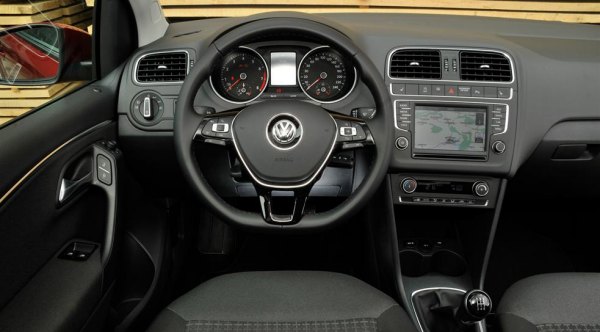
|
Thanks to the update, the Polo is safe to stay near the top of the
class for a couple more years. That said, it is still a bit boring to
me. I do hope the next generation to be more adventurous, both in
styling and driver appeal.
|
Verdict:     |
| Published
on 11
Dec
2014 |
All rights reserved.
|
|
Polo GTI 1.8
|
|
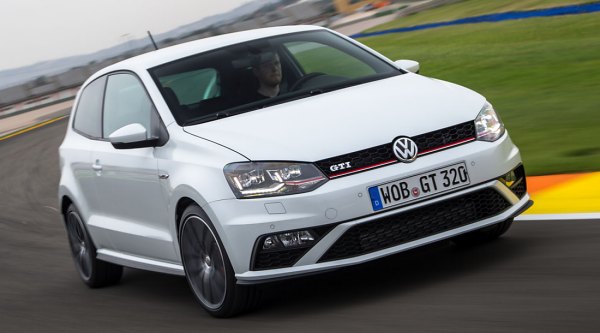
|
Headline news about the
facelifted Polo GTI is a new 1.8 TSI engine, replacing the old 1.4
Twincharger. It comes from the new EA888 family that power the Golf
GTI, with the same long list of technology such as dual-mode injection
(direct or port), variable exhaust valve lift, dual-variable cam
phasing and a turbocharger integrated with the exhaust manifolds.
Larger capacity allows the turbo to blow at lower pressure yet manages
to add 12 horsepower. Peak torque is still limited by the 7-speed DSG
gearbox at 184 lbft, but it is present across a wider band, starting
from merely 1250 rpm and sustaining until 5300 rpm. Such a super-flat
torque curve gives you even fewer reasons to exploit the redline, which
could be actually a downside to keen drivers.
Fortunately, the new car is now also available with a 6-speed manual
gearbox. Previously, many potential customers were turned off by the
lack of manual box, which is still the choice for the majority of hot
hatch drivers. This hurt its sales and let Ford Fiesta ST, Peugeot 208
GTI etc. to dominate. VW finally realized the problem and have it
sorted. Its gearchange is decent, if not Honda-slick. It gives you more
control and a greater sense of involvement. Moreover, the manual box
offers another advantage: it is more robust, thus it allows the engine
to deliver its full 236 lbft of torque. That said, in the real world
this extra punch is not obvious. As the manual GTI loses more time
during each gearchange, it is actually no quicker than the DSG car –
both quote a 0-60 mph time of 6.4 seconds, a couple of tenths faster
than the old car. Top speed is lifted by 5 mph to 147.
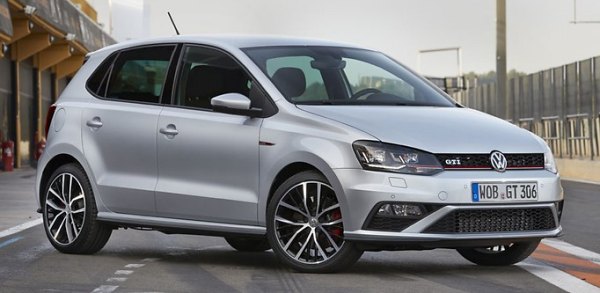 |
The old Polo GTI was never lack of performance, but it was relatively
weak in terms of driver engagement. Volkswagen tries to sort this out
with stiffer suspension tuning, a set of adjustable (but not adaptive)
dampers and a Sport mode button which alters the suspension, steering,
throttle and exhaust noise. The XDS artificial locking differential is
now linked with ESP system. On the road, the car does display better
control in tight bends, with less roll if you engaged the Sport mode.
It offers more traction and is less likely to spin its inside front
wheel. However, to call it entertaining is probably overstated. Its
steering feel remains largely artificial, failing to connect the driver
to the road surface. The balance of the car biases towards safe
understeer in typical Volkswagen style. It takes some aggressive
provocation to slide its tail. Even when you have the stability control
switched off, it actually remains working in the background and correct
things without your permission. This Volkswagen does not trust its
driver, neither does it gel with its driver. In terms of driver appeal,
it is not up to the game of Golf GTI and Golf R, let alone the level of
Ford Fiesta ST. The exhaust note is quite dull, too. Press the Sport
button only triggers the audio system to play synthetic sound through
the speakers, and the fake noise is annoyingly loud.
Nevertheless, the Polo GTI is still a good car, if not a good GTI. Its
ride quality should be regarded as excellent in the hot hatch field.
Its interior build quality, sophisticated electronics and fuel economy
are first class. The classical tartan cloth buckets are both good
looking and supportive. As an everyday transport it is hard to fault.
Just don’t expect the same kind of driving thrills that you can enjoy
on Fiesta ST.
|
Verdict:     |
|
|
|
|
|
|
|
|
|
|
Polo
1.2
|
2009
|
| Front-engined,
FWD |
| Steel monocoque |
| Mainly steel |
| 3970 / 1682 / 1462 mm |
| 2470 mm |
Inline-3
|
| 1198 cc |
DOHC 12 valves
|
| - |
| - |
70 hp
|
82 lbft
|
5-speed manual
|
F: strut
R: torsion-beam
|
| - |
| 175/70R14 |
992 kg
|
| 102 mph (c) |
13 (est)
|
| - |
|
Polo
1.2TSI
|
2009
|
| Front-engined,
FWD |
| Steel monocoque |
| Mainly steel |
| 3970 / 1682 / 1462 mm |
| 2470 mm |
Inline-4
|
| 1197 cc |
SOHC 8 valves
|
| Turbo |
| DI |
105 hp
|
129 lbft
|
6-speed manual
|
F: strut
R: torsion-beam
|
| - |
| 185/60R15 |
1010 kg
|
| 119 mph (c) |
9.0 (c)
|
| - |
|
Polo
1.6TDI
|
2009
|
| Front-engined,
FWD |
| Steel monocoque |
| Mainly steel |
| 3970 / 1682 / 1462 mm |
| 2470 mm |
Inline-4 diesel
|
| 1598 cc |
DOHC 16 valves
|
| VTG turbo |
| CDI |
105 hp
|
184 lbft
|
5-speed manual
|
F: strut
R: torsion-beam
|
| - |
| 185/60R15 |
1090 kg
|
| 118 mph (c) |
9.8 (c)
|
| - |
|
|
|
|
|
Performance
tested by: -
|
|
|
|
|
|
|
Polo
GTI
|
2010
|
| Front-engined,
FWD |
| Steel monocoque |
| Mainly steel |
| 3979 / 1682 / 1452 mm |
| 2468 mm |
Inline-4
|
| 1390 cc |
DOHC 16 valves
|
Turbo + supercharger
|
| DI |
180 hp / 6200 rpm
|
184 lbft / 2000-4500 rpm
|
7-speed twin-clutch
|
F: strut
R: torsion-beam
|
| - |
| 215/40VR17 |
1184 kg
|
| 142 mph (c) |
6.6 (c)
|
| - |
|
Polo 1.0
|
2014
|
| Front-engined,
FWD |
| Steel monocoque |
| Mainly steel |
| 3972 / 1682 / 1453 mm |
| 2470 mm |
Inline-3
|
| 999 cc |
DOHC 12 valves, VVT
|
| - |
| - |
75 hp
|
70 lbft
|
5-speed manual
|
F: strut
R: torsion-beam
|
| - |
| 185/60R15 |
975 kg
|
| 107 mph (c) |
13.5 (est)
|
| - |
|
Polo 1.2TSI
|
2014
|
| Front-engined,
FWD |
| Steel monocoque |
| Mainly steel |
| 3972 / 1682 / 1453 mm |
| 2470 mm |
Inline-4
|
| 1197 cc |
DOHC 16 valves
|
| Turbo |
| DI |
110 hp
|
129 lbft
|
6-speed manual
|
F: strut
R: torsion-beam
|
| - |
| 185/60R15 |
1060 kg
|
| 122 mph (c) |
8.7 (c)
|
| - |
|
|
|
|
|
Performance tested by: -
|
|
|
|
|
|
|
Polo 1.4TDI
|
2014
|
| Front-engined,
FWD |
| Steel monocoque |
| Mainly steel |
| 3972 / 1682 / 1453 mm |
| 2470 mm |
Inline-3 diesel
|
| 1422 cc |
DOHC 12 valves
|
| VTG turbo |
| CDI |
90 hp
|
170 lbft
|
5-speed manual
|
F: strut
R: torsion-beam
|
| - |
| 185/60R15 |
1076 kg
|
| 114 mph (c) |
10.2 (c)
|
| - |
|
Polo 1.4TSI BlueGT
|
2014
|
| Front-engined,
FWD |
| Steel monocoque |
| Mainly steel |
| 3972 / 1682 / 1453 mm |
| 2470 mm |
Inline-4
|
| 1395 cc |
DOHC 16 valves, DVVT
|
| Turbo |
DI, cylinder deactivation
|
150 hp
|
184 lbft
|
7-speed twin-clutch
|
F: strut
R: torsion-beam
|
-
|
| 215/45VR16 |
-
|
| 132 mph (est) |
7.4 (est)
|
| - |
|
Polo GTI 1.8
|
2014
|
| Front-engined,
FWD |
| Steel monocoque |
| Mainly steel |
| 3983 / 1682 / 1443 mm |
| 2468 mm |
Inline-4
|
| 1798 cc |
DOHC 16 valves, DVVT, VVL
|
Turbo
|
| DI |
192 hp / 4200-6200 rpm
|
236 lbft / 1450-4200 rpm
(DSG: 184 lbft / 1250-5300)
|
6-speed manual
(7-speed twin-clutch)
|
F: strut
R: torsion-beam
|
Adjustable damping
|
| 215/40VR17 |
1197 kg (1205 kg)
|
| 147 mph (c) |
6.4 (c)
|
| - |
|
|
|
|
|
| Performance tested by: - |
|
|
|
|
|
|
|
|
Copyright©
1997-2014
by Mark Wan @ AutoZine
|
|